Legislative Analyst's Office, December 1998
|

|
1998 Cal Facts
California's Demographics
|
California's Population Growth Rebounding
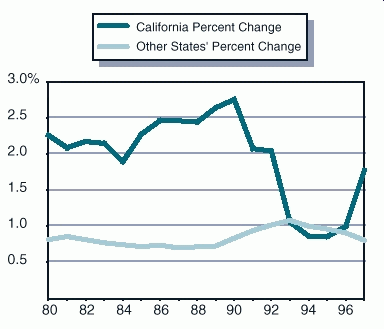
- For much of the prior two decades, California's population grew at roughly twice the rate of the other 49 states.
- Consequently, California's share of the nation's population has grown steadily, rising from under 10 percent in 1970 to 12 percent in 1990.
- The recession brought an end to this trend. Between 1993 and 1995, California actually grew more slowly than the rest of the nation. More recently, the
state's population growth rate has turned up once again in response to improved economic conditions.
The Majority of Californians Live in Southern California
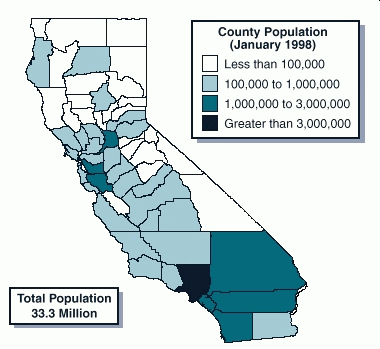
- Two-thirds of the population live in the eight counties with populations of greater than one million. Five of those eight counties are in Southern California.
- Just under 30 percent of all Californians live in Los Angeles County alone.
- A total of 6.7 million people--about one in five--live in the nine-county San Francisco Bay Area.
During the 1990s, the Inland Counties Have Grown Fastest
Total Growth, 1990 Through 1997
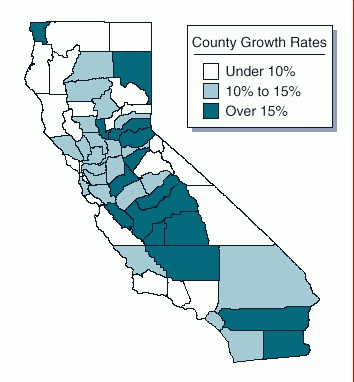
- The highest population growth rates have occurred this decade mainly in the Central Valley and foothill counties, and in Riverside and Imperial Counties in
Southern California.
- Slow growth in Los Angeles County resulted in an overall statewide growth over the period of 11.7 percentcompared to a growth rate of 13.2 percent for the
other 57 counties.
California's Twenty Largest Cities
| Population Rank |
City |
Population as of
January 1, 1998 |
|
|
|
| 1 |
Los Angeles |
3,722,500 |
| 2 |
San Diego |
1,224,800 |
| 3 |
San Jose |
894,000 |
| 4 |
San Francisco |
789,600 |
| 5 |
Long Beach |
446,200 |
|
|
|
| 6 |
Fresno |
411,600 |
| 7 |
Oakland |
396,300 |
| 8 |
Sacramento |
392,800 |
| 9 |
Santa Ana |
311,200 |
| 10 |
Anaheim |
301,200 |
|
|
|
| 11 |
Riverside |
250,800 |
| 12 |
Stockton |
241,100 |
| 13 |
Bakersfield |
221,700 |
| 14 |
Fremont |
198,700 |
| 15 |
Glendale |
197,600 |
|
|
|
| 16 |
Huntington Beach |
192,400 |
| 17 |
Modesto |
182,700 |
| 18 |
San Bernardino |
182,600 |
| 19 |
Chula Vista |
162,000 |
| 20 |
Oxnard |
156,000 |
|
|
|
- One-third of all Californians live in the state's twenty largest cities.
- Eleven of these cities are located in Southern California, while another five are located in the Central Valley.
- Of the state's 471 cities, 55 have populations in excess of 100,000.
More People Again Coming to California From Other States
Net Domestic In-Migration
(In Thousands)
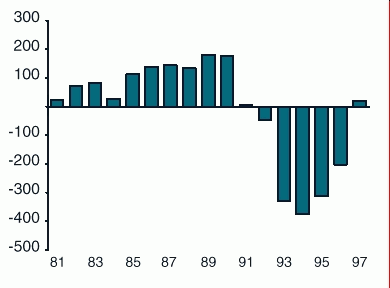
- California has always been a destination for people coming from other states ("domestic in-migration") and from other countries ("foreign in-migration").
- While foreign in-migration remained steady throughout the 1990s, domestic in-migration was an entirely different story. Due principally to the state's economic difficulties, more people left the
state each year from 1992 through 1996 than came into California from other states. This trend has recently reversed.
Hispanics and Asians Will Lead State's Population Growth
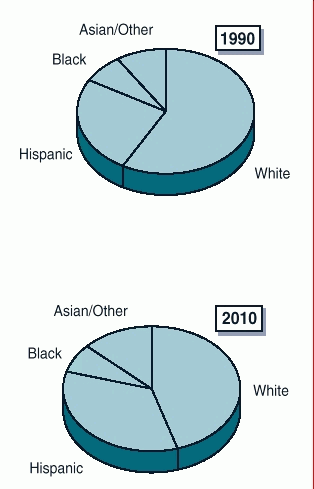
- Between 1990 and 2010, California's Hispanic population will grow by 83 percent, and the state's Asian population will grow even faster94 percent.
- The projected growth in the state's white (non-Hispanic) population is about 7 percent over the same period.
California's Population Growth to Vary Dramatically by Age Group
1998 Through 2004
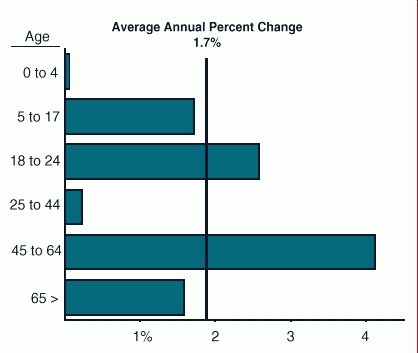
- California's median age will be increasing, as baby boomers enter their late 40s and 50s.
- The K-12 school-age population will grow at a rate similar to the general population over the next six years. The number of preschoolers, however, is projected to remain almost constant over the
same period, leading to a future slowdown in the K-12 population.
- By comparison, the college-age population's growth rate will be somewhat faster than the general population.
Continue to 1998 Cal Facts California's Fiscal Structure
Return to 1998 Cal Facts California's Economy
Return to 1998 Cal Facts Table of Contents
Return to LAO Home Page






